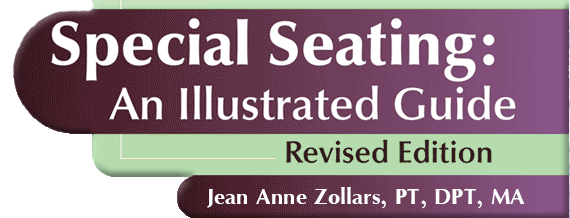Special Seating:
An Illustrated Guide
Revised Edition
By Jean Anne Zollars, PT, DPT, MA
Table of Contents - Special Seating: An Illustrated Guide Revised Edition
Introduction - 1
Benefits of Seating – 6
Posture – 7
Understanding the Pelvis-Spine Connection – 10
Assessment - 17
Reasons for the Seating Assessment
Health Issues Related to the Person’s Disability
Environmental Issues
Transportation Issues
Assessment of Present Seating/Mobility System
Funding Issues
Physical Assessment: Posture, Movement, and Function – 26
Posture in Present Seating/Mobility System
Functional Abilities in Present Seating/Mobility System
Joint and Muscular Flexibility
Balance and Postural Control in Sitting
Assessment in Sitting: Flexibility and Postural Support
The Effect of Gravity in Sitting
Pressure
Simulation & Measurements – 95
Hand Simulation
Translating Information from Your Hands into Words
Pre-simulation Objectives of the Seating System
Measurements
Simulation with Materials
Functional Abilities in the Simulated Seating System
Clarifying Objectives – 115
Matching the Person’s and Equipment’s Objectives
Designing the Seating System - 122
The Back Support
The Seat Cushion
Design Options
Seating Supports for Specific Postural Problems - 131
Rolled Backward or Sliding Forward (Posterior Pelvic Tilt)
Rolled Forward (Anterior Pelvic Tilt)
Tilted to the Side (Lateral Pelvic Tilt)
Turned (Rotated)
The Trunk – 160
Curved Forward (Kyphosis)
Curved to the Side (Scoliosis)
Rotated Forward (Rotated)
Arched Backward (Extended)
The Hips and Legs – 180
Moved Towards Midline (Adducted) and Turned In (Internally Rotated)
Spread Open (Abducted) and Turned Out (Externally Rotated)
Turned to the Same Side (Windswept)
Bent Up Excessively (Flexed)
Moving Constantly
The Knees – 189
Bent (Flexed)
Straight (Extended)
The Ankles and Feet – 195
Foot Support-to-Leg Angle
Ankle/Foot Supports
The Head and Neck – 202
Falls or Pushes Back (Extends)
Falls (Laterally Flexes), or Rotates to One Side
Falls or Pulls Forward (Flexes)
Moves Excessively in All Planes
Is Large
The Shoulder Girdles – 212
Shrugged Upwards (Elevated)
Pulled Forward and Turned In (Protracted and Internally Rotated)
Pulled Backward and Turned Out (Retracted and Externally Rotated)
The Arms – 218
One Arm Stiffened Straight (Extended), the Other Bent (Flexed)
One Arm Strong, The Other Weak
Both Arms Stiffly Bent (Flexed)
Both Arms Stiffly Straight (Extended)
Arms Moving Uncontrollably
Stabilize One Arm to Improve Function of Other Arm
Self-Abusive Behaviors
Pressure Relief Cushions – 225
Extrinsic and Intrinsic Factors
Pressure
Tips for Keeping Tissue Healthy
Qualities of Cushions
Cushion Covers
Types of Cushions
Wheelchair Considerations – 235
Seat Surface Height at Front Edge
Width of the Wheelchair/Mobility System
The Position of the Seating System Within the Mobility System
Arm Supports
Lower Leg Supports and Foot Supports
Cushion Covering
System Tilt
Transporting the Seating/Mobility System
Putting It All Together - 251
The Person’s Postural and Functional Objectives
The Objectives of the Seating System
The Objectives of the Mobility System and Other Objectives
The Characteristics and Components of the Seating System
The Seating System in Relationship to the Mobility System
Translating Body Measurements into Seating Components
Fitting Tips
Special Considerations - 257
General Considerations
Cerebral Palsy
Traumatic Brain Injury
Orthopedic Issues
Osteogenesis Imperfecta
Muscular Dystrophy
Pain
Multiple Sclerosis
Leg Amputations
The Elderly
Hemiplegia
Spinal Cord Injury
Spina Bifida
Sharing Stories - 287
Martita’s Story
David’s Story
Kyo’s Story
Thomas’s Story
Nadia’s Story
Richard’s Story
Resources - 317
Suggested Reading – 331
Appendices – 333
Seating Assessment Form – Long
Seating Assessment Form – Short
Measurement of Seating Components
Aaron’s Seating Assessment Form
About the Book
Jean Anne published her first edition of Special Seating: An Illustrated Guide in 1996 following her work with people with disabilities in countries ranging from Malaysia to the United States. At that time there was not a guide to assess and design appropriate seating and mobility systems for people with disabilities. She wrote the book to fill that void.
- A step-by-step process to evaluate and design seating/mobility systems
- Easy-to-read text and clear illustrations
- A new chapter on seating and mobility considerations for people with specific conditions
- Review of current best practices and research from seating experts worldwide
- Emphasis on "hand simulation"
- More ideas using simulation with materials
- New design ideas, guidelines and fitting tips
- Updated assessment forms
- Innovative ideas for people working in less-resourced settings
Online Course
Pediatric Seating and Mobility CEU online video course from Clinician's View.
$90 for 4.5 Contact Hours
Join Jean Anne Zollars, PT, DPT, MA and Rose Vallejo, PT, ATP as they take you through the process of assessment, hand simulation, material simulation and wheelchair documentation for children.
On the Clinicians-View.com home page, click CEU Courses, then under Dressing and Positioning, you will see Pediatric Seating and Mobility, or Go directly to the Pediatric Seating and Mobility course description.

